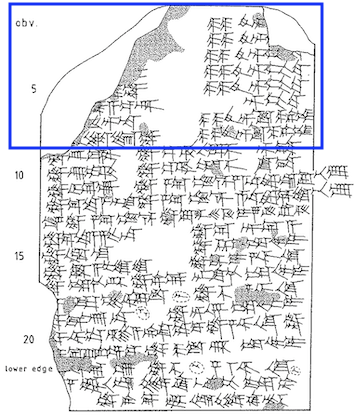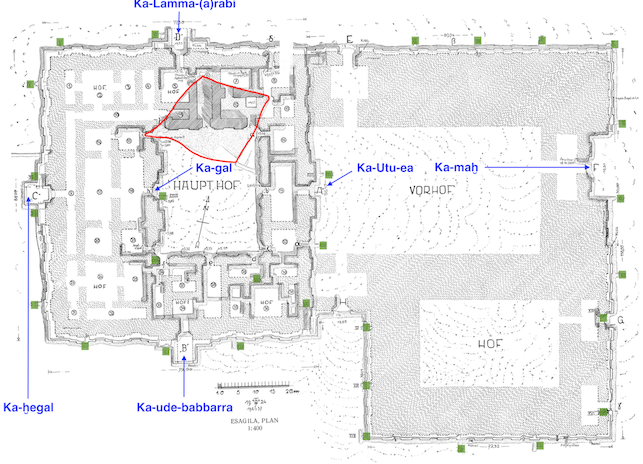Holy Rooms and Gates of Esagil


A.R. George's hand-drawn facsimile of the obverse of BM 35046, a clay tablet inscribed with a text called the "Gate List of Esagil A." Esagil's gates are listed in obverse lines 1–8. Reproduced from A.R. George, Babylonian Topographical Texts, pl. 21.
Information about Esagil's rooms, gates, and daises is provided by a number of cuneiform sources, including Tintir = Babylon Tablet II, three lists of gates, the so-called "Esagil Tablet" (a mathematical school tablet), a text recording the measurements of Esagil and Ezida, Ludlul Bel Nemeqi Tablet IV, and Neo-Assyrian and Neo-Babylonian royal inscriptions. Some of the details provided in these texts are not just for Babylon's principal temple, but also for other religious buildings in the Esagil temple complex, namely Ekarzagina (the temple of the god Ea), Enamtaggaduha (the temple of the god Amurru), Erabriri (the temple of the god Madānu), and Eturkalama (the temple of the goddess Bēlet-Bābili [= the Ištar of Babylon]).
The most important rooms and seats mentioned in the aforementioned sources, especially in royal inscriptions, are in alphabetical order:
- Court of Bēl: central courtyard of the main part of Esagil
- Court of the goddess Ištar and the god Zababa
- Dais of Destinies (Akkadian parak šīmāti): byname of Duku
- Dukisikil: seat of the deities Enmešara and Enbilulu
- Duku: seat of the god Marduk as Lugaldimmeranki in Ubšukkina during the New Year's festival
- Dukukinamtartarede: full name of Duku
- Edadihegal
- Edara'ana: cella of the goddess Zarpanitu
- Ehalanki: seat of the goddess Zarpanitu in Edara'ana
- Eumuša: cella of the god Marduk
- Ezida: cella of the god Nabû
- Grand Court: main courtyard of the eastern annex building
- Tiamat: seat of the god Marduk in Eumuša
- Ubšukkina: court of divine assembly
- Ubšukkina-mezuhalhala: full name of Ubšukkina

Annotated plan of Esagil showing the deep 20×20-meter pit (outline in red) and the smaller pits dug around the perimeter of the temple (green), as well as the proposed locations of the temple's most important gateways (blue). Adapted from F. Wetzel, Das Hauptheiligtum des Marduk in Babylon, Esagila und Etemenanki pl. 3.
The most important gateways of Esagil, according to those same texts, were:
- Gate of Bēltīya: northern gate of the main temple of Esagil (= Ka-Lamma-arabi)
- Kaezida: gate of Ezida
- Kagal: central western gate of the Court of Bēl (= Gate h)
- Kagula
- Ka-hegal: western gate of the main temple (= Gate C)
- Kahilisu: gate of Edara'ana; sometimes a byname of Ehalanki
- Ka-Lamma-arabi northern gate of the main temple (= Gate D)
- Kamah: main entrance of Esagil (= Gate F of the eastern annex building)
- Kasikila: main (eastern) entrance to the Esagil complex from the Processional Way
- Kasulima: gate of Eumuša (= unexcavated Gate m; also known as Kasilima)
- Ka-ude-babbar southern gate of the main temple (= Gate B)
- Ka-Utu-e eastern gate of the main temple (= Gate A)
Banner image: areal photograph of the excavation pits and trenches in the area of the remains of Esagil and Etemenanki taken in 1923 (left); a reconstruction of Esagil and Etemenanki during the reign of the Neo-Babylonian king Nebuchadnezzar II (center); a plan of Esagil, and Etemenanki (right). Images from O. Pedersén, Babylon: The Great City, pp. 144–145 figs. 4.3–4.4 and p. 151 fig. 4.11.
Jamie Novotny
Jamie Novotny, 'Holy Rooms and Gates of Esagil', Babylonian Temples and Monumental Architecture online (BTMAo), The BTMAo Project, a sub-project of MOCCI, [http://oracc.org/btmao/Babylon/TemplesandZiggurat/Esagil/RoomsandGates/]